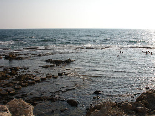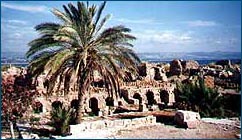| Random image |
 |

Puncho Beach (Amchit)
|
 |
|
 |
 |
TYRE
 About 83 km south of Beirut, Tyre is Lebanon's fourth
largest city and declared by UNESCO in 1979 as a World
Heritage Site. About 83 km south of Beirut, Tyre is Lebanon's fourth
largest city and declared by UNESCO in 1979 as a World
Heritage Site.
Also known as the "Queen of Seas", Tyre was founded at the
start of the third millennium BC, originally consisting of a
mainland settlement and a modest island off shore. It was
not until the first millennium BC that the city experienced
its golden age, when Hiram, King of Tyre, extended the city
by joining two islets by landfill.
Phoenician expansion began about 815 BC when traders from
Tyre founded Carthage in North Africa. Eventually its
colonies spread around the Mediterranean and Atlantic,
bringing to the city a flourishing maritime trade.
 The walled city was besieged for 13 years in the 6th century
B.C. by Nebuchadnezzar, King of Babylon. The city stood
firm, but the residents of the mainland had to abandon it.
In 332 B.C. the city was conquered by Alexander the Great to
serve him as a strategic point in the war between the Greeks
and the Persians, and was half destroyed. Around 30,000 of
the town's residents were massacred or sold to slavery. The walled city was besieged for 13 years in the 6th century
B.C. by Nebuchadnezzar, King of Babylon. The city stood
firm, but the residents of the mainland had to abandon it.
In 332 B.C. the city was conquered by Alexander the Great to
serve him as a strategic point in the war between the Greeks
and the Persians, and was half destroyed. Around 30,000 of
the town's residents were massacred or sold to slavery.
Romans had their hand on the city in 64 B.C. and built many
great monuments, including an aqueduct, a triumphal arch,
and the largest hippodrome in antiquity, which remained till
now. Tyre also succumbed to Muslim Conquest, and flourished
under their rule exporting sugar, pearl, and glass.
Excavations on the site have uncovered remains of the
Crusader, Arab, Byzantine and Graeco-Roman cities. Herodotus
of Halicarnassus, "Father of History" visited Tyre during
the 5th century B.C. and described the famous Temple of
Melkart (Heracles).
Between the 12th and 4th centuries BC, Tyre flourished
because of its maritime trade and became renowned for its
Tyrian purple dye, its glass industry and its Phoenician
overseas settlements in the Mediterranean. Being extremely
costly "Tyrean" purple was worn as mark of imperial or royal
rank.
The Greeks believed that various aspects of their
civilization had their origin in Tyre. The introduction of
the alphabet into Greece was attributed to Cadmus of Tyre,
and it was Europa, the sister of Cadmus, who gave her name
to the continent. Elissa princess and daughter of king
Mattan of Tyre city, extended Tyre's empire through the
Mediterranean and founded Carthage in 814 B.C.
Tyre is divided into Three Areas.
 Area One is a vast district of civic buildings, colonnades,
public baths, mosaic streets and a rectangular arena. The
columns to the left belong to Palaestra, an area where
athletes trained. Other excavated remains on this site date
to the Hellenistic, Roman and Byzantine periods. A short
distance from the shore there are "islands" which are, in
fact, the great stone breakwaters and jetties of the ancient
Phoenician port called the "Egyptian port" because it faced
South towards Egypt. Area One is a vast district of civic buildings, colonnades,
public baths, mosaic streets and a rectangular arena. The
columns to the left belong to Palaestra, an area where
athletes trained. Other excavated remains on this site date
to the Hellenistic, Roman and Byzantine periods. A short
distance from the shore there are "islands" which are, in
fact, the great stone breakwaters and jetties of the ancient
Phoenician port called the "Egyptian port" because it faced
South towards Egypt.
Area Two has a Crusader Castle, and a few re-erected granite
columns that are impressive. The area has also revealed a
network of Roman-Byzantine roads and other installations.
Visitors are not allowed inside the site, but the ruins can
be viewed from the road.
Area Three consists of an extensive necropolis, a three-bay
monumental arch and one of the largest Roman hippodromes
ever found, dating from the 2nd Century AD to the 6th
Century AD.
From the entrance of the site all the way to the sea there
is a mosaic street flanked with cipolin marble columns,
surrounded with remains of baths and a residential area.
Archaeologists have recently discovered what may possibly be
the remains of the oldest basilica built in the 4th century
by Paulinos, the Bishop of Tyre, in Tyre's residential El
Bass neighborhood.
The most important recent archaeological find in Tyre is a
Phoenician cemetery from the first millennium BC discovered
in 1991 during clandestine excavations. It is the first
cemetery of its kind found in Lebanon. Funeral jars,
inscribed steles and jewellery were among the objects
retrieved from the site. The importance of this historical
city and its monuments were highlighted in 1979 when UNESCO
declared Tyre a World Heritage Site.
Necropolis
The necropolis, excavated in 1962, yielded hundreds of
ornate stone and marble sarcophagi of the Roman and
Byzantine periods. Foundations of a Byzantine Church can
also be seen. The archway stands astride a Roman road that
led into the ancient city. Alongside the road there are
remains of the aqueduct that assured the city its water
supply.
Hippodrome
South of the necropolis is the partially reconstructed Roman
hippodrome excavated in 1967. The 480 meter structure seated
20,000 spectators who gathered to watch the death defying
sport of chariot racing. Each end of the course was marked
by still existing stone turning posts (metae). Charioteers
had to make this circuit 7 times. Rounding the metae at top
speed was the most dangerous part of the race an often
produced spectacular spills.
Quarter of Sand
The walk to Area Three takes you through a residential part
of Tyre called Hay Er-Raml or the Quarter of Sand. You are
in fact walking on what once was Alexander the Great's
causeway. Accumulating sands and extensive landfill have
expanded this old land link to the extent that modern
visitors have the impression that Tyre is built on a
peninsula.
|